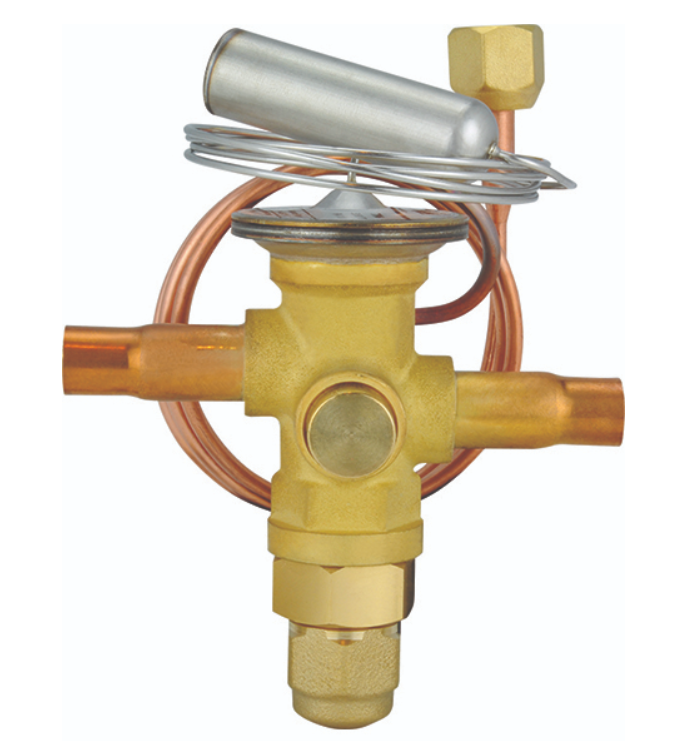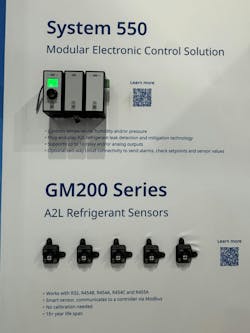Key Takeaways
- TXVs Control Superheat: These valves maintain constant superheat at the evaporator outlet to protect compressors
- 3 Operating Forces: Sensing bulb pressure (opening), evaporator pressure (closing), and spring tension (closing) work in balance
- Small Adjustments Matter: Only adjust 1/8 to 1/4 turn, then wait 15-30 minutes between adjustments
- Common Failures: Lost bulb charge slams valve shut; loose bulb mounting causes flooding
Thermostatic Expansion Valves (TXV) are the most popular Type of Refrigerant Metering Device. They are popular due to their superior control of Refrigerant Flow, and their ability to react to changes in product or space “Load“. They also have a low relative cost compared to other types of Metering Devices.
The TXV design is intuitive, but certain concepts must be understood to properly install, check, adjust, and troubleshoot systems that use this Metering Device. Images in this article (otherwise the Forces Diagram) are courtesy of Danfoss.
Note: the TXV can only be used on Dry Expansion Evaporator Coils. They cannot be used on Flooded Evaporator Coils.
There are many different configurations and options available on TXV’s, but this article will focus on an introduction to the Thermostatic Expansion Valve, its main parts, and general operation and troubleshooting. For a broader understanding of metering device types, see our guide on adaptive vs fixed expansion valves.
Note: the Electronic Expansion Valve (EXV) is a related Metering Device which can be set up to control Refrigerant Flow on Superheat, or other desired system parameters.
Introduction to the 3 Operating Forces
(Force 1) The Thermostatic Expansion Valve operates on the premise of controlling Evaporator outlet Superheat. It is sometimes referred to as a “Superheat Valve“. This is accomplished by mounting the valve’s “Bulb” (see image below) on the Evaporator’s outlet pipe. This outlet pipe’s temperature influences the refrigerant inside the bulb to boil, and sends force through the “Capillary tube” onto the “Diaphragm” to assist in opening the valve.
Watch this quick explanation of Basic TX Valve Operation And Its Three Forces from our YouTube channel to see these forces in action.
“Spring Tension” (Force 3) is an adjustable Closing Force set on the valve. Referencing the above image, the bottom brass “Nut” is removed to allow access to the “Adjusting Screw”: rotating clockwise increases Spring Tension and Superheat, and rotating counterclockwise reduces this.
The valve’s outlet pressure (or Evaporator inlet pressure, Force 2) also must be considered, as it has a Closing Force on the underside of the Diaphragm.
Note: the outlet of the Evaporator needs to have Superheat, or the TXV will not be able to work properly. If you're dealing with frozen evaporator coils, check the TXV operation after thawing.
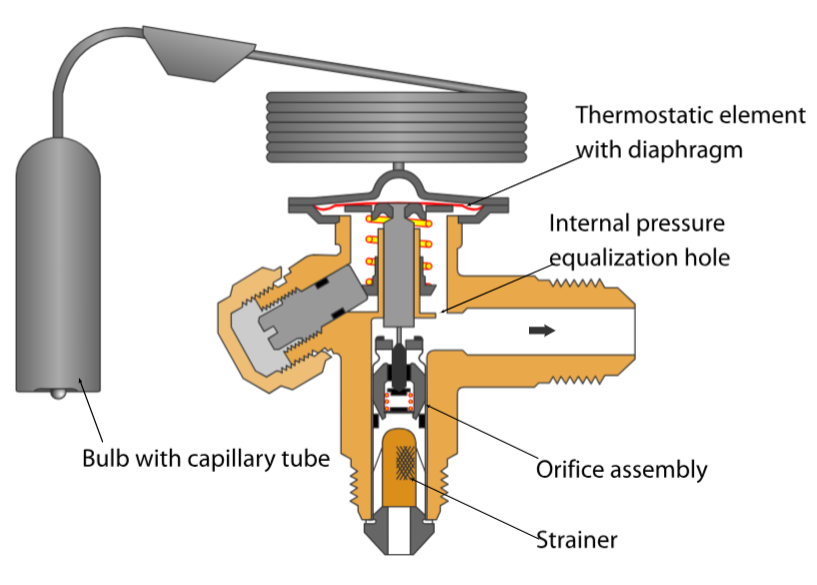
Operating Forces Diagram
The best way to understand TXV operation and adjustment is to memorize how to draw the diagram below. It simply explains the 3 Operating Forces, and gives a visual reference to how they interact with each other. The order we cover the Forces will be as follows: Force 1, Force 3, then Force 2. This order is used for the best explanation and understanding.
Note: the titles of these 3 forces (or "Pressures") are internationally accepted/referenced. The "line" reference below is the horizontal line drawn across the middle of the diagram.
Force 1: Sensing Bulb Pressure is positioned at the top of the line as the valve’s Opening Force. When there is an increase in the temperature (Superheat) that the Bulb measures on the Evaporator outlet, the valve opens more to allow more Refrigerant into the Evaporator. This additional Refrigerant fed to the Evaporator reduces Superheat at the Evaporator Outlet.
Force 3: Spring tension is positioned at the bottom of the line as one of the TXV’s Closing Forces. The more the adjusting screw is tightened (clockwise rotation), the greater the influence to close will be, increasing operating Superheat. If rotated counterclockwise, the valve’s operating Superheat will be reduced.
Force 2: Evaporator Inlet Pressure is positioned at the bottom of the line as another of the TXV’s Closing Forces. It acts in tandem with Spring Pressure to oppose Sensing Bulb Pressure.
Note: Evaporator coils that present "high" pressure drops utilize an External Equalizer Tube to reference a more accurate F2 Pressure from the Evaporator Coil's Outlet. This allows for proper "reference pressure" for F2 despite coil pressure drop.
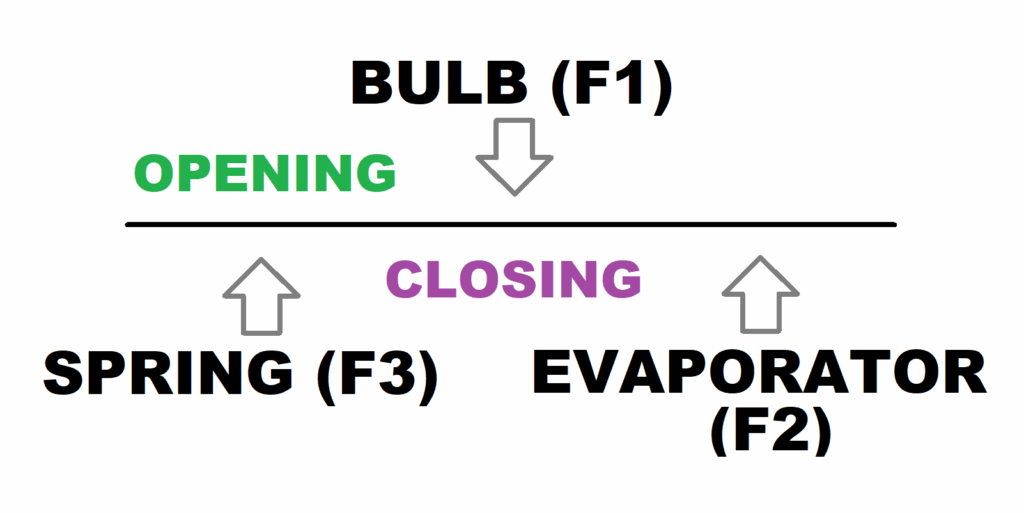
Interaction of the 3 Forces
F1 = F2 + F3: when this condition is true, the TXV is “in balance”. This will be the operating state referenced for this operating example. Note that when the valve is in balance, the valve is open and is nicely controlling the flow of Refrigerant into the Evaporator coil while maintaining Evaporator Superheat.
As previously mentioned, the Forces (1, 2, and 3) relate to Pressure. An example would be:
F1 = 70 PSIG (Pressure from Sensing bulb)F2 = 55 PSIG (Pressure from Evaporator Inlet)
F3 = 15 PSIG (Pressure from Spring)
When filling these into the formula:
F1 = F2 + F370 PSIG = 55 PSIG + 15 PSIG
70 PSIG (opening force) = 70 PSIG (closing force)
Therefore, the valve is in balance.
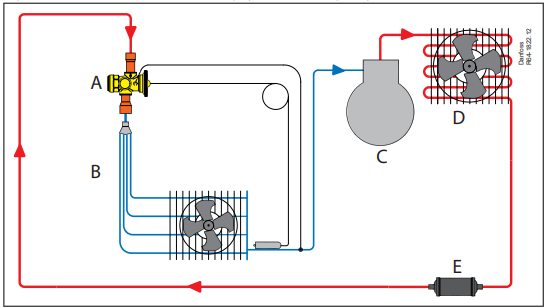
Adjustment, and TXV Reaction to Common Issues
Adjustment of an operating TXV’s Adjusting Screw should be done slowly, with small adjustments. It is best to only adjust by 1/8 to ¼ turn of the valve stem, and to wait at least 15 minutes (or 30 minutes) before making additional adjustments.
Check out our Instagram post on how to check superheat for a quick visual guide that complements TXV adjustment procedures.
If the Sensing Bulb is mounted poorly (loose, not strapped properly, or in extreme cases, the bulb has fallen off the pipe), it will cause more heat from the Refrigerated Space to influence the Bulb (the Refrigerated Space is warmer than the Evaporator Outlet Pipe). This will cause the valve to open more, reducing Superheat and causing coil Flooding.
If the Bulb Charge is lost (Capillary tube breaks, or manufacturer brazed connection leaks), the TXV will lose its Opening Force, and the valve will slam closed.
Installation Best Practices
Proper installation is critical for TXV performance. The Danfoss TU stainless steel TXV doesn’t require wrapping during brazing, making installation more straightforward.
Learn proper brazing techniques in our video on How to Braze a TXV.
Additional Troubleshooting Considerations
When diagnosing TXV issues, always verify the basics first:
- Check system airflow and refrigerant charge
- Ensure proper bulb mounting (4 or 8 o’clock position on horizontal lines)
- Verify the valve is properly sized for the application
- Check for moisture or contaminants that could affect valve operation
For heat pump applications, technicians should also understand bi-flow TXV operation.
Watch this Interview with Jamie Kitchen on How TX Valves Adapt to Multiple Refrigerants and Improve Heat Pumps.
Professional Service Excellence
Experienced technicians know that preparation makes all the difference in efficient service. Property.com’s ‘Know Before You Go‘ tool helps HVAC professionals arrive at service calls with detailed property insights, including equipment history and homeowner preferences. This preparation is especially valuable when diagnosing TXV issues that may require system history knowledge. Learn how Property.com helps certified technicians deliver premium service and grow their businesses.
Summary
TXVs are the most common metering device in Refrigeration and Air Conditioning Systems. They are versatile to use in Dry Expansion Evaporator Coils as they act as a “Superheat Valve” to maintain constant Superheat at the Evaporator Outlet. Their design is intuitive yet simple, but a thorough understanding of the 3 Operating Forces of the valve is required to adjust or troubleshoot a TXV.
Whether you require installation, repair, or maintenance, our technicians will assist you with top-quality service at any time of the day or night. Take comfort in knowing your indoor air quality is the best it can be with MOE heating & cooling services Ontario's solution for heating, air conditioning, and ventilation that’s cooler than the rest.
Contact us to schedule a visit. Our qualified team of technicians, are always ready to help you and guide you for heating and cooling issues. Weather you want to replace an old furnace or install a brand new air conditioner, we are here to help you. Our main office is at Kitchener but we can service most of Ontario's cities
Source link

